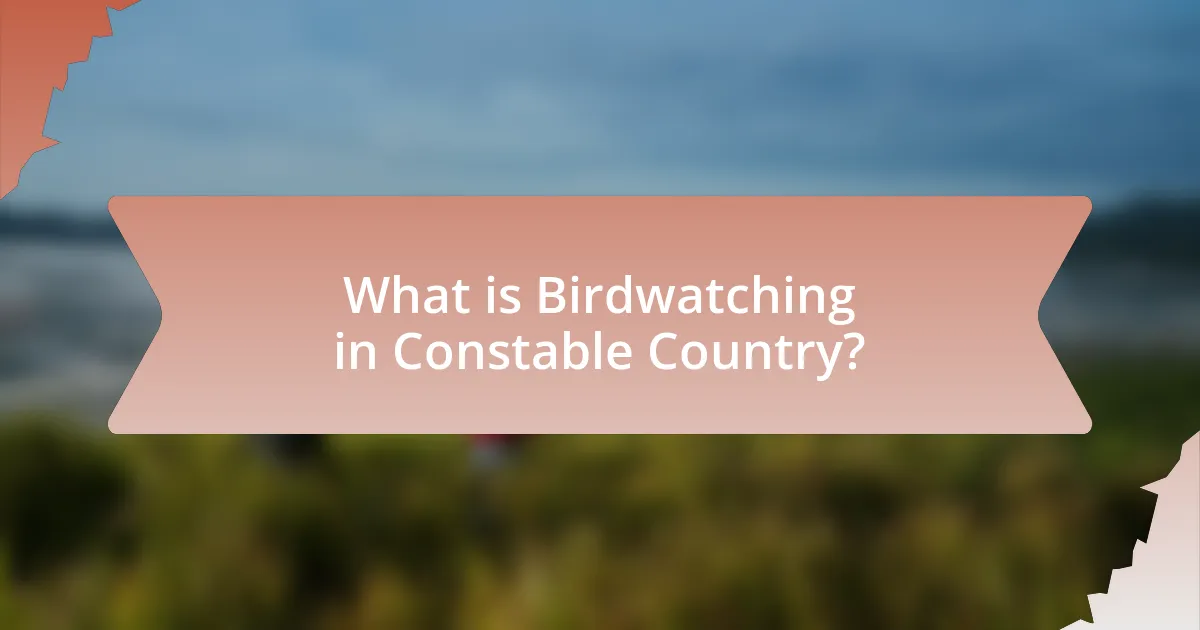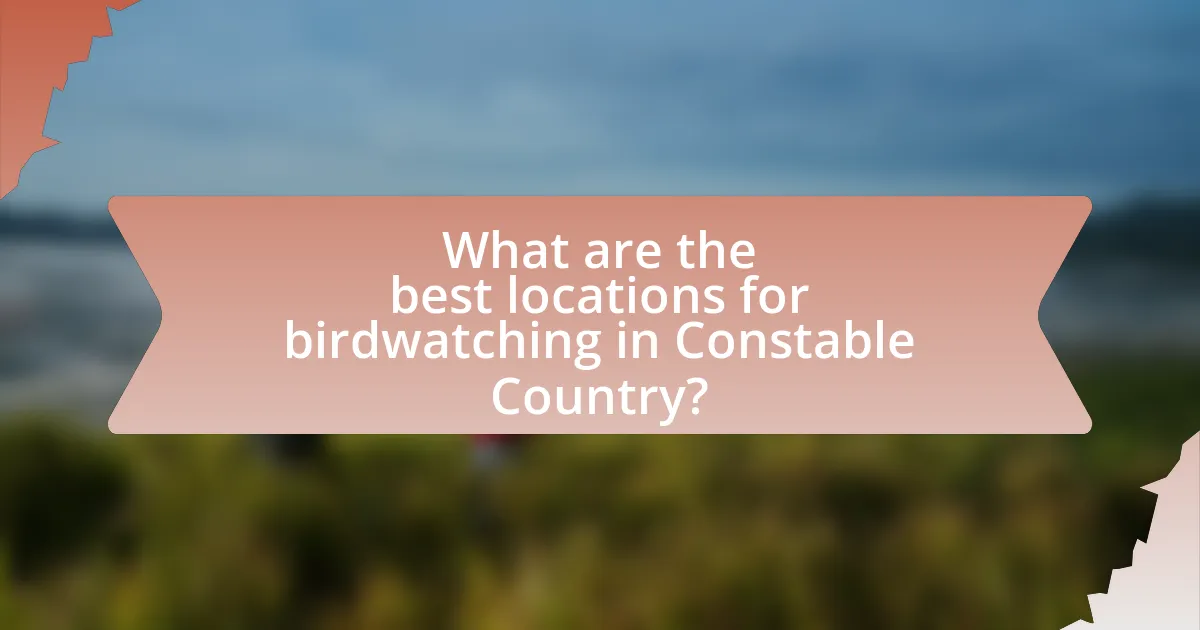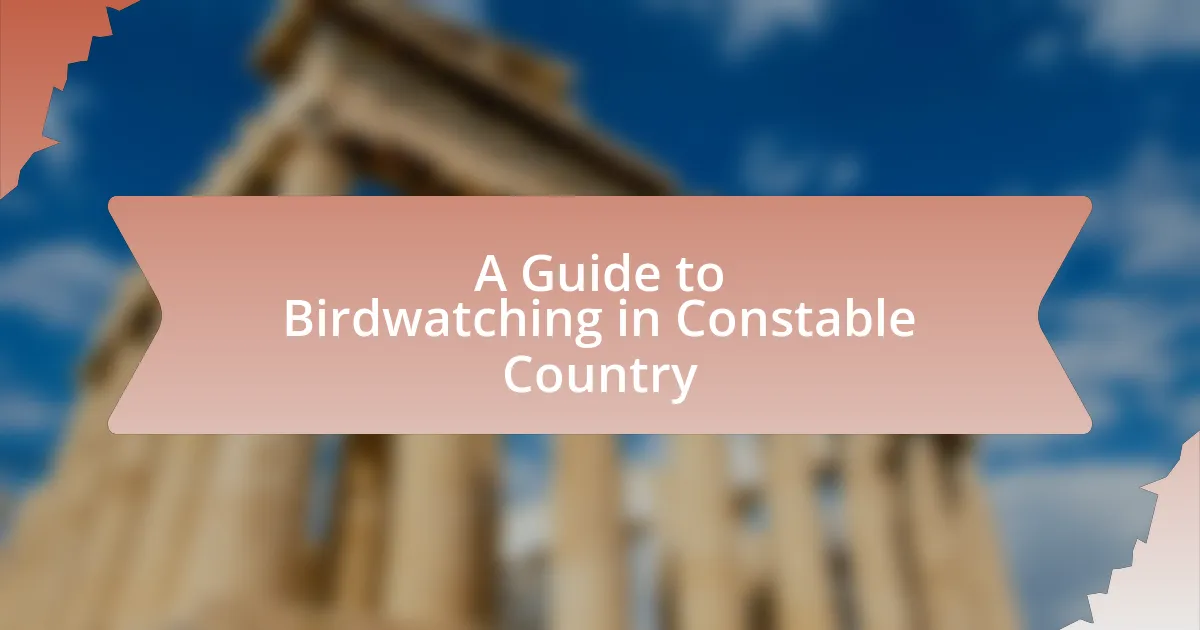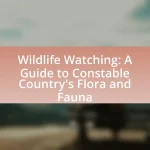Birdwatching in Constable Country refers to the activity of observing and identifying various bird species in the diverse landscapes of Suffolk, England. This region is characterized by its rich biodiversity, featuring habitats such as wetlands, woodlands, and farmland that support a wide variety of birds, including migratory and resident species. The article provides insights into the unique habitats, common bird species, and seasonal migration patterns, as well as practical tips for beginners on how to get started with birdwatching. Additionally, it discusses the best locations for observation, essential equipment, and responsible birdwatching practices to enhance the experience while contributing to conservation efforts.

What is Birdwatching in Constable Country?
Birdwatching in Constable Country is the activity of observing and identifying various bird species in the scenic landscapes of this region in Suffolk, England. This area, known for its picturesque countryside and rich biodiversity, provides habitats for numerous bird species, making it a popular destination for both amateur and experienced birdwatchers. The presence of diverse ecosystems, including wetlands, woodlands, and farmland, supports a wide variety of birds, such as herons, warblers, and raptors, enhancing the birdwatching experience.
Why is Constable Country a popular destination for birdwatching?
Constable Country is a popular destination for birdwatching due to its diverse habitats that support a wide variety of bird species. The area features wetlands, woodlands, and open fields, which attract both migratory and resident birds. Notably, the presence of the River Stour and its surrounding landscapes creates ideal conditions for species such as herons, kingfishers, and various songbirds. Additionally, the region is part of the Dedham Vale Area of Outstanding Natural Beauty, which enhances its ecological significance and provides birdwatchers with scenic views and rich biodiversity.
What unique habitats can be found in Constable Country?
Constable Country features unique habitats such as wetlands, ancient woodlands, and river valleys. These environments support diverse bird species, including waterfowl in the wetlands, woodland birds in the forests, and various species along the riverbanks. The presence of these habitats contributes to the area’s rich biodiversity, making it a prime location for birdwatching enthusiasts.
How does the landscape influence bird diversity in the area?
The landscape significantly influences bird diversity in the area by providing varied habitats that support different species. Diverse landscapes, such as wetlands, woodlands, and grasslands, create niches for various birds, allowing for a higher number of species to coexist. For instance, studies have shown that regions with a mix of habitats can support up to 50% more bird species compared to uniform landscapes. This is evidenced by the presence of both migratory and resident birds in Constable Country, where the interplay of agricultural fields, rivers, and forests fosters a rich avian community.
What types of birds can be observed in Constable Country?
In Constable Country, birdwatchers can observe a variety of species, including the Eurasian Wren, Common Blackbird, and European Robin. These birds thrive in the diverse habitats of the area, which include woodlands, wetlands, and open fields. The presence of these species is supported by the rich biodiversity and varied ecosystems found in Constable Country, making it an ideal location for birdwatching enthusiasts.
Which migratory birds visit Constable Country during different seasons?
Constable Country hosts various migratory birds throughout the seasons. In spring, species such as the Swallow and House Martin arrive, while summer sees the presence of the Common Tern and the Yellow Wagtail. During autumn, migratory birds like the Barnacle Goose and the Eurasian Curlew can be observed, and in winter, the area attracts species such as the Brent Goose and the Redwing. These seasonal patterns are influenced by the region’s diverse habitats, which provide essential resources for these birds during their migratory journeys.
What are the most common resident bird species in the region?
The most common resident bird species in Constable Country include the European Robin, Great Tit, and Blue Tit. These species are frequently observed throughout the year due to their adaptability to various habitats in the region. The European Robin is known for its distinctive red breast and melodious song, while the Great Tit and Blue Tit are recognized for their vibrant colors and social behavior. Their presence is supported by the diverse ecosystems found in Constable Country, which provide ample food sources and nesting sites.
How can beginners get started with birdwatching in Constable Country?
Beginners can get started with birdwatching in Constable Country by choosing suitable locations such as Dedham Vale and Flatford, which are known for their diverse bird populations. These areas provide habitats for various species, including waterfowl and songbirds, making them ideal for observation. Additionally, beginners should equip themselves with a pair of binoculars and a field guide to help identify birds. Engaging in local birdwatching groups or guided tours can also enhance the experience, as these often provide valuable insights and tips from experienced birdwatchers.
What essential equipment is needed for birdwatching?
Essential equipment needed for birdwatching includes binoculars, a field guide, and a notebook. Binoculars allow birdwatchers to observe birds from a distance, enhancing detail visibility; models with 8×42 magnification are commonly recommended for their balance of power and field of view. A field guide provides information on bird species, aiding in identification, while a notebook helps record observations and notes about sightings. These tools are fundamental for effective birdwatching, as they enhance the experience and facilitate learning about avian species.
How can one identify different bird species effectively?
To identify different bird species effectively, one should utilize a combination of visual observation, auditory recognition, and field guides. Visual observation involves noting key characteristics such as size, color patterns, and distinctive markings, while auditory recognition focuses on identifying calls and songs unique to each species. Field guides provide detailed descriptions and images that aid in accurate identification. Research indicates that experienced birdwatchers often rely on these methods, enhancing their ability to distinguish between similar species, as evidenced by studies showing that visual and auditory cues significantly improve identification accuracy.

What are the best locations for birdwatching in Constable Country?
The best locations for birdwatching in Constable Country include the Stour Valley, Flatford Marsh, and Dedham Vale. The Stour Valley is known for its diverse habitats, attracting various bird species such as herons and kingfishers. Flatford Marsh offers excellent vantage points for observing waterfowl and waders, while Dedham Vale provides a picturesque setting for spotting songbirds and raptors. These areas are recognized for their rich biodiversity, making them ideal for birdwatching enthusiasts.
Which parks and reserves are recommended for birdwatching?
The recommended parks and reserves for birdwatching in Constable Country include Dedham Vale Area of Outstanding Natural Beauty, Flatford Wildlife Garden, and the Stour Valley Path. Dedham Vale is known for its diverse bird species, including waterfowl and songbirds, due to its varied habitats. Flatford Wildlife Garden offers a rich environment for observing garden birds and migratory species. The Stour Valley Path provides excellent vantage points for spotting raptors and other birds along the river. These locations are recognized for their biodiversity and accessibility, making them ideal for birdwatching enthusiasts.
What features make these locations ideal for observing birds?
Locations ideal for observing birds typically feature diverse habitats, abundant food sources, and minimal human disturbance. Diverse habitats, such as wetlands, woodlands, and grasslands, provide various nesting and feeding opportunities for different bird species. Abundant food sources, including insects, seeds, and fruits, attract a wide range of birds, enhancing observation chances. Minimal human disturbance ensures that birds feel safe to forage and nest, increasing visibility for birdwatchers. These characteristics are essential for creating an environment conducive to birdwatching, as supported by studies indicating that areas with high habitat diversity correlate with greater bird species richness.
How can visitors access these birdwatching sites?
Visitors can access birdwatching sites in Constable Country primarily by utilizing designated walking trails, public transport, and private vehicles. The area features well-marked paths that lead to popular birdwatching locations, making it easy for visitors to navigate. Additionally, local bus services connect key sites, providing an alternative for those without personal transportation. The accessibility of these sites is further enhanced by the presence of parking facilities near major birdwatching areas, allowing visitors to conveniently reach their destinations.
What seasonal considerations should birdwatchers keep in mind?
Birdwatchers should consider seasonal migration patterns, breeding seasons, and food availability when planning their activities. During spring and fall, many bird species migrate, making these seasons ideal for spotting a variety of birds. Breeding seasons, typically in late spring and early summer, can affect bird behavior, as many species become more territorial and vocal. Additionally, food availability changes with the seasons; for instance, winter may limit the number of birds present, while summer often sees an increase in insect-eating species. Understanding these seasonal dynamics enhances the birdwatching experience in Constable Country.
How does the time of year affect birdwatching opportunities?
The time of year significantly affects birdwatching opportunities by influencing bird migration patterns, breeding seasons, and species availability. During spring and fall, many migratory birds pass through areas like Constable Country, providing unique viewing opportunities. For instance, the arrival of migratory species such as warblers and shorebirds in spring can attract birdwatchers eager to observe these transient populations. Additionally, summer offers the chance to see nesting behaviors and fledglings, while winter may reveal resident species that are less active during warmer months. Seasonal changes in habitat, such as foliage and food availability, also impact bird visibility and behavior, making certain times of the year more favorable for birdwatching.
What specific events or migrations should birdwatchers plan for?
Birdwatchers should plan for the spring and autumn migrations of various bird species in Constable Country. During spring, typically from March to May, migratory birds such as swallows, warblers, and various raptors return to the area for breeding. In autumn, from September to November, species like geese and ducks migrate south, providing excellent viewing opportunities. These migrations are well-documented phenomena, with studies indicating that millions of birds travel thousands of miles during these seasons, making them prime times for birdwatching enthusiasts.

What tips can enhance the birdwatching experience in Constable Country?
To enhance the birdwatching experience in Constable Country, birdwatchers should focus on visiting during early morning or late afternoon when birds are most active. This timing aligns with the natural behavior of many species, increasing the likelihood of sightings. Additionally, using binoculars with a magnification of at least 8x can improve visibility and detail, allowing for better identification of various bird species. Observing from quiet locations, such as near water bodies or dense foliage, can also attract more birds, as these areas provide essential resources. Lastly, familiarizing oneself with local bird species and their calls can significantly enhance the experience, as it allows birdwatchers to recognize and locate birds more effectively.
How can birdwatchers improve their observation skills?
Birdwatchers can improve their observation skills by practicing focused attention and utilizing field guides for identification. Focused attention enhances the ability to notice subtle details in bird behavior and plumage, which is crucial for accurate identification. Studies show that regular practice in varied environments increases observational accuracy; for instance, a study published in the Journal of Avian Biology found that experienced birdwatchers could identify species more quickly and accurately than novices due to their developed observational skills. Additionally, using field guides helps birdwatchers learn specific characteristics of different species, reinforcing their ability to recognize and remember key features.
What techniques can help in spotting elusive bird species?
Techniques that can help in spotting elusive bird species include using stealthy observation methods, employing high-quality optics, and understanding bird behavior. Stealthy observation involves minimizing noise and movement to avoid startling birds, which is crucial for approaching skittish species. High-quality optics, such as binoculars or spotting scopes, enhance visibility and detail, allowing birdwatchers to identify species from a distance without disturbing them. Understanding bird behavior, including feeding patterns and vocalizations, aids in predicting their locations and activities, increasing the chances of successful sightings. These techniques are supported by studies indicating that careful observation and knowledge of avian habits significantly improve birdwatching success rates.
How can one maintain a respectful distance from wildlife?
To maintain a respectful distance from wildlife, individuals should observe animals from a minimum distance of 100 yards for larger species and 25 yards for smaller ones. This distance helps to minimize stress on the animals and reduces the risk of human-wildlife conflicts. Research indicates that close encounters can disrupt animal behavior, leading to negative impacts on their health and survival. For example, a study published in the journal “Biological Conservation” found that human presence can alter the feeding and breeding patterns of various wildlife species. Therefore, using binoculars or spotting scopes can enhance the viewing experience while ensuring a safe distance is kept.
What resources are available for birdwatchers in Constable Country?
Birdwatchers in Constable Country can access various resources, including local birdwatching guides, nature reserves, and organized birdwatching events. The RSPB (Royal Society for the Protection of Birds) provides detailed information on bird species and habitats in the area, while local nature reserves such as the Stour Estuary and Dedham Vale offer prime birdwatching locations. Additionally, community groups often organize birdwatching walks and workshops, enhancing the experience for both novice and experienced birdwatchers.
Where can one find local birdwatching guides or tours?
Local birdwatching guides or tours can be found through various resources such as local wildlife organizations, nature reserves, and dedicated birdwatching websites. For instance, the RSPB (Royal Society for the Protection of Birds) offers guided tours and events in many regions, including Constable Country. Additionally, platforms like Birdwatching.com and local tourism websites often list available tours and guides, providing specific details about dates, locations, and booking options. These resources ensure that birdwatchers can connect with knowledgeable guides who are familiar with the local avifauna and habitats.
What online platforms provide information on bird species and sightings?
Online platforms that provide information on bird species and sightings include eBird, BirdLife International, and the Audubon Society. eBird, managed by the Cornell Lab of Ornithology, allows users to report and access bird sightings globally, with over 100 million observations recorded. BirdLife International offers a comprehensive database of bird species and conservation status, while the Audubon Society provides resources for bird identification and local sightings. These platforms are widely recognized for their contributions to ornithology and birdwatching communities.
What are some common challenges faced by birdwatchers in Constable Country?
Birdwatchers in Constable Country commonly face challenges such as unpredictable weather conditions, limited access to certain habitats, and the presence of invasive species. Unpredictable weather can affect visibility and bird activity, making it difficult to spot species. Limited access to specific areas, often due to private land or conservation restrictions, can hinder birdwatching opportunities. Additionally, invasive species can disrupt local ecosystems, impacting the populations of native birds and complicating identification efforts for birdwatchers.
How can weather conditions impact birdwatching plans?
Weather conditions significantly impact birdwatching plans by influencing bird activity and visibility. For instance, overcast skies can enhance visibility as birds are more active during cooler temperatures, while sunny weather may lead to reduced bird activity during peak heat. Additionally, rain can deter birdwatchers and affect bird behavior, as many species seek shelter during inclement weather. Windy conditions can also make it difficult to spot birds, as they may remain hidden in dense foliage. Studies indicate that specific weather patterns correlate with increased bird sightings, such as migratory movements during favorable weather conditions.
What strategies can help overcome obstacles during birdwatching trips?
To overcome obstacles during birdwatching trips, birdwatchers should plan ahead, utilize appropriate gear, and remain adaptable. Planning ahead involves researching bird species, their habitats, and seasonal behaviors, which increases the likelihood of successful sightings. Utilizing appropriate gear, such as binoculars, field guides, and weather-appropriate clothing, enhances the birdwatching experience and mitigates discomfort. Remaining adaptable allows birdwatchers to adjust their plans based on weather conditions or unexpected challenges, such as changes in bird activity. These strategies are supported by the fact that successful birdwatching often relies on preparation and flexibility, as noted in studies on wildlife observation techniques.
What are the best practices for responsible birdwatching?
The best practices for responsible birdwatching include maintaining a respectful distance from birds, minimizing disturbance to their habitats, and adhering to local regulations. Birdwatchers should use binoculars or spotting scopes to observe birds without intruding on their space, as close proximity can stress wildlife and disrupt their natural behaviors. Additionally, staying on designated trails helps protect sensitive ecosystems, while avoiding loud noises ensures that birds are not frightened away. Following these practices contributes to the conservation of bird populations and their environments, promoting a sustainable birdwatching experience.
How can birdwatchers contribute to conservation efforts?
Birdwatchers can contribute to conservation efforts by participating in citizen science projects that monitor bird populations and habitats. These activities provide valuable data that help researchers track changes in bird species and their environments, which is crucial for conservation planning. For example, initiatives like the Audubon Society’s Christmas Bird Count involve thousands of volunteers who collect data on bird sightings, contributing to long-term studies on bird health and habitat conditions. This collective effort aids in identifying trends, informing policy decisions, and promoting habitat protection, thereby enhancing conservation strategies.
What guidelines should be followed to minimize disturbance to wildlife?
To minimize disturbance to wildlife, individuals should maintain a safe distance from animals, avoid loud noises, and refrain from feeding wildlife. Keeping a distance of at least 100 meters from nesting birds is crucial, as closer proximity can lead to stress and abandonment of nests. Additionally, using binoculars or spotting scopes allows for observation without encroaching on their space. Research indicates that human presence can significantly alter animal behavior, leading to increased stress levels and reduced reproductive success. Following these guidelines helps protect wildlife and ensures a more sustainable birdwatching experience in Constable Country.


